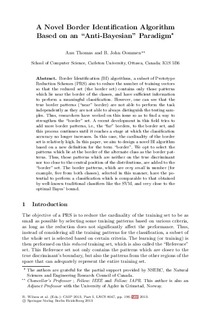| dc.contributor.author | Thomas, Anu | |
| dc.contributor.author | Oommen, B. John | |
| dc.date.accessioned | 2014-01-16T12:07:19Z | |
| dc.date.available | 2014-01-16T12:07:19Z | |
| dc.date.issued | 2013 | |
| dc.identifier.citation | Thomas, A., & Oommen, B. J. (2013). A novel Border Identification algorithm based on an “Anti-Bayesian” paradigm. In R. Wilson, E. Hancock, A. Bors & W. Smith (Eds.), Computer Analysis of Images and Patterns (Vol. 8047, pp. 196-203): Springer. | no_NO |
| dc.identifier.isbn | 978-3-642-40260-9 | |
| dc.identifier.uri | http://hdl.handle.net/11250/138022 | |
| dc.description | Published version of a chapter in the book: Computer Analysis of Images and Patterns. Also available from the publisher at: http://dx.doi.org/10.1007/978-3-642-40261-6_23 | no_NO |
| dc.description.abstract | Border Identification (BI) algorithms, a subset of Prototype Reduction Schemes (PRS) aim to reduce the number of training vectors so that the reduced set (the border set) contains only those patterns which lie near the border of the classes, and have sufficient information to perform a meaningful classification. However, one can see that the true border patterns (“near” border) are not able to perform the task independently as they are not able to always distinguish the testing samples. Thus, researchers have worked on this issue so as to find a way to strengthen the “border” set. A recent development in this field tries to add more border patterns, i.e., the “far” borders, to the border set, and this process continues until it reaches a stage at which the classification accuracy no longer increases. In this case, the cardinality of the border set is relatively high. In this paper, we aim to design a novel BI algorithm based on a new definition for the term “border”. We opt to select the patterns which lie at the border of the alternate class as the border patterns. Thus, those patterns which are neither on the true discriminant nor too close to the central position of the distributions, are added to the “border” set. The border patterns, which are very small in number (for example, five from both classes), selected in this manner, have the potential to perform a classification which is comparable to that obtained by well-known traditional classifiers like the SVM, and very close to the optimal Bayes’ bound. | no_NO |
| dc.language.iso | eng | no_NO |
| dc.publisher | Springer | no_NO |
| dc.relation.ispartofseries | Lecture Notes in Computer Science;8047 | |
| dc.title | A novel Border Identification algorithm based on an “Anti-Bayesian” paradigm | no_NO |
| dc.type | Chapter | no_NO |
| dc.type | Peer reviewed | no_NO |
| dc.subject.nsi | VDP::Mathematics and natural science: 400::Mathematics: 410::Algebra/algebraic analysis: 414 | no_NO |
| dc.subject.nsi | VDP::Mathematics and natural science: 400::Information and communication science: 420::Algorithms and computability theory: 422 | no_NO |
| dc.source.pagenumber | 196-203 | no_NO |
| dc.identifier.doi | 10.1007/978-3-642-40261-6_23 | |
